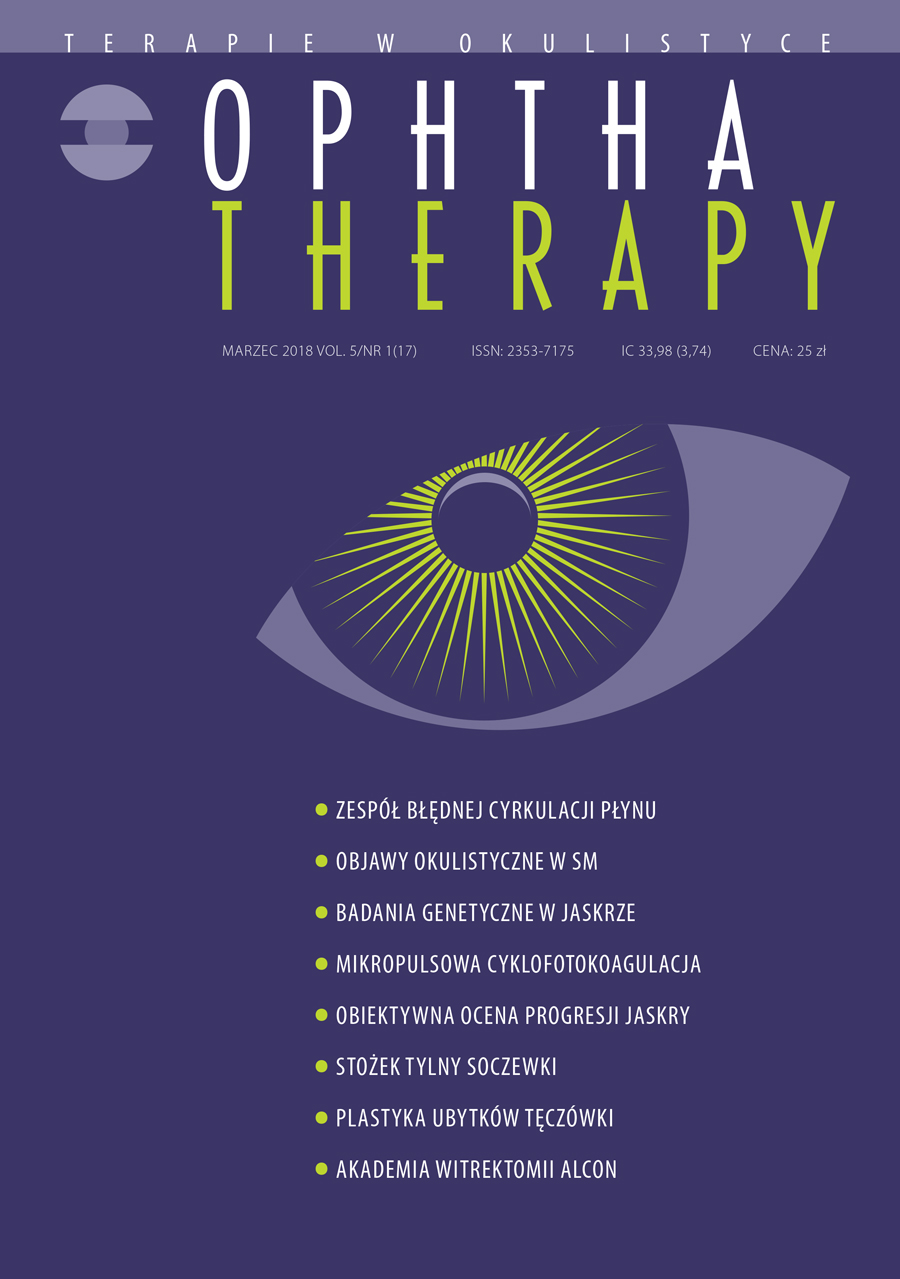Możliwości stosowania mikropulsowej cyklofotokoagulacji jako opcji leczenia pacjentów z różnymi postaciami jaskry
##plugins.themes.bootstrap3.article.main##
Abstrakt
Mikropulsowa cyklofotokoagulacja, w przeciwieństwie do metody tradycyjnej, jest bezpieczna i powoduje podobne obniżenie ciśnienia wewnątrzgałkowego, nie wywołując cyklodestrukcji ani istotnego stanu zapalnego. Spośród ponad 60 chorych leczonych w naszym ośrodku w Krakowie w okresie od czerwca 2016 r. do grudnia 2017 r. poddaliśmy retrospektywnej ocenie 12 pacjentów (17 oczu) badanych 12 miesięcy po zabiegu. Grupa obejmowała 6 kobiet i 6 mężczyzn w wieku od 33 do 85 lat. U 6 chorych występowała jaskra wtórna, u 4 – jaskra pierwotna otwartego kąta, a u 2 – jaskra zamkniętego kąta. Średnie obniżenie ciśnienia wyniosło po 12 miesiącach 27%, przy czym w 8 oczach było to powyżej 30%. Nie odnotowano powikłań ani reakcji zapalnej w całym okresie obserwacji.
Pobrania
##plugins.themes.bootstrap3.article.details##

Utwór dostępny jest na licencji Creative Commons Uznanie autorstwa – Użycie niekomercyjne – Bez utworów zależnych 4.0 Międzynarodowe.
Copyright: © Medical Education sp. z o.o. License allowing third parties to copy and redistribute the material in any medium or format and to remix, transform, and build upon the material, provided the original work is properly cited and states its license.
Address reprint requests to: Medical Education, Marcin Kuźma (marcin.kuzma@mededu.pl)
Bibliografia
2. Aquino MC, Barton K, Tan AM et al. Micropulse versus continuous wave transscleral diode cyclophotocoagulation in refractory glaucoma: a randomized exploratory study. Clin & Experimental Ophthalmol. 2015; 43(1): 40-6.
3. Liu GJ, Mizukawa A, Okisaka S. Mechanism of intraocular pressure decrease after contact transcleral continous wave Nd: YAG Laser cyclophotocoagulation. Ophthalmic Res. 1994; 26: 65-79.
4. Tan A, Chockalingam M, Aquino M et al. Micropulse transscleral diode laser cyclophotocoagulation in the treatment of refractory glaucoma. Clin & Experimental Ophthalmol. 2010; 38(3): 266-72.
5. Lee N. Made-in-Singapore treatment for glaucoma more effective, has fewer side effects. The Straits Times. 24.05.2017.
6. Lin S, Babic K, Masis M et al. Micropulse transscleral diode laser cyclophotocoagulation: Short term results and anatomical effects. Poster 23 presented at: American Glaucoma Society 26th Annual Meeting; March 3-6, 2016; Fort Lauderdale, FL, USA.
7. Maslin JS, Chen P, Sinard J et al. Comparison of acute histopathological changes in human cadaver eyes after MicroPulse and continuous wave transscleral cyclophotocoagulation. Presented at: American Glaucoma Society 26th Annual Meeting; March 3-6, 2016; Fort Lauderdale, FL, USA.
8. Noecker RJ. Applying micropulse transscleral cyclophotocoagulation for early stage Glaucoma. Ophthalmology Times. 1 November 2017.
9. Toyos M, Toyos R. Clinical outcomes of micropulsed transcleral cyclophotocoagulation in moderate to severe glaucoma. J Clin Exp Ophthalmol. 2016; 7: 6.
10. Kuchar S, Moster M, Reamer CB et al. Treatment outcomes of micropulse transscleral cyclophotocoagulation in advanced glaucoma. Lasers Medical Science. 2016; 31: 393-6.
11. Mahootchi A. Modality approaches bilateral glaucoma in single treatment. Ophthalmology Times Europe. 2016; 12: 5-6.
12. Resende A, Moster M, Waisbourd M. A prospective pilot study evaluating the novel micropulse transscleral cyclophotocoagulation: short-term results. AGS abstract, San Diego, March 3-6, 2016.
13. Zagórski Z, Molęda-Gładysz K. Micropulse Transscleral CFC in the management of different glaucomas. Poster: 32 APAO Congress, Singapore, 1-5.03.2017.
14. Zagórski Z. Micropulse TCPC as a treatment option for a wide range of glaucoma patients. Presented at: ESASO Day Conference, Lublin, 24–25.11.2017.

